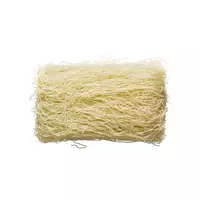Funchosa noodles

Funchosa noodles (fenchosa, funchesa, fenchese or fuchese) refer to popular Asian cuisine products. The second and most famous name for domestic foodies, hostesses and chefs is funchosa noodles - glass or starch noodles. Funchosa noodles are sold dried and ready to eat. Glass noodles received their second name due to their appearance. The fact is that after cooking, thin white threads of funchosa noodles become transparent.
It is noteworthy that many are mistaken and attribute funchose noodles to rice species of the product. However, rice noodles and glass noodles differ strikingly from each other and not only in appearance, as well as in taste and consumer characteristics. Rice noodles are made from rice flour, during the cooking process the product changes its color to white. Funchose noodles become translucent and look like thin glass threads.
Composition of funchose noodles
Funchosa noodles include legume starch (mung, potato, yams, cassava or canna). Nowadays, funchose noodles are increasingly made from corn starch. Moreover, the use of cheaper corn starch in the composition of funchose noodles has become the basis for the Chinese authorities in applying sanctions to unscrupulous producers. The thing is that corn starch does not have the same taste or consumer properties as mung bean funchose noodles. Therefore, manufacturers began to bleach the starting material with lead.
As a result, funchosa noodles from low-quality raw materials began to harm the health of consumers. It is noteworthy that poisonous Chinese funchosa noodles were sold not only domestically, but also exported. The last scandal with funchosa noodles occurred in 2010, when the authorities of the Republic of Czech Republic found heavy metal aluminum in the product and banned the sale of Chinese noodles.
Benefits of funchosa
The calorie content of funchosa noodles is at a fairly high level. 100 grams of the product contains about 320 Kcal, which is quite a lot. It should be noted that the funchosa noodles themselves do not have a pronounced taste, the product is rather tasteless, so it is often served as a side dish for meat or fish dishes. In this regard, the calorie content of funchose noodles may change. The benefits of funchosa lie in the vitamin-mineral composition of noodles.
Funchose contains a large amount of B, E and PP vitamins. The same tangible and obvious benefit of funchose lies in the content of minerals such as phosphorus, potassium, selenium, magnesium and iron. Usually, funchosa noodles are not salted when cooking or frying the product. All spices and spices are added to the sauce, which is served to the noodles. In Asia, funchosa noodles are prepared in a variety of ways. Sour-sweet or spicy salads with funchosa noodles, as well as first and main dishes, are incredibly popular.
funchose noodles 320 kCal
Energy value of funchose noodles (Ratio of proteins, fats, carbohydrates - ju):
Proteins: 0.7 g (~ 3 kCal)
Fats: 0.5 g (~ 5 kCal)
Carbohydrates: 84g (~ 336kCal)
Energy ratio (bj | y): 1% | 1% | 105%
 Español
Español Français
Français Português
Português Русский
Русский 简体中文
简体中文 繁體中文
繁體中文 日本語
日本語 한국어
한국어 العربية
العربية Türkçe
Türkçe Қазақ
Қазақ Deutsch
Deutsch Italiano
Italiano Українська
Українська
